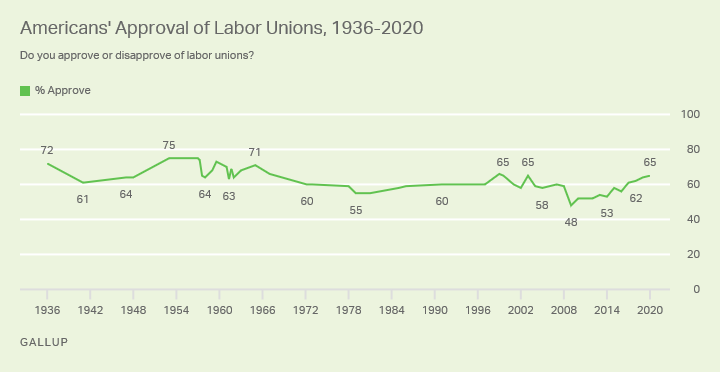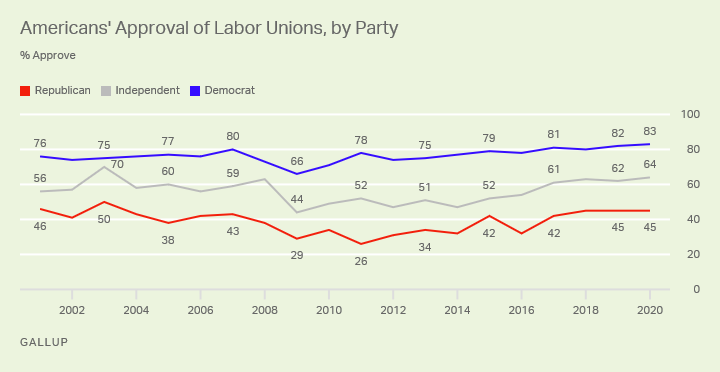A new Gallup poll shows a majority of Americans still believe in the power of collective bargaining.
“This shows that, once again, working people believe in their right to have a voice on the job,” said International President Lonnie R. Stephenson. “It’s not a fringe notion, it’s mainstream. People can see that there’s power in a union.”
According to the polling organization’s annual Labor Day poll, 65% of Americans approve of unions, the highest it’s been since 2003. Gallup also noted that public support has been steadily rising from a low point of 40% in 2008 during the Great Recession.
Gallup began tracking union sentiment in 1936, the beginning of the modern labor movement, and found support at 72%. It peaked at 75% in the mid-1950s. And while collective bargaining support has tended to drop during times of economic unrest, the report notes that this has not been the case this time around. With millions of Americans out of work due to the coronavirus and unemployment at a near-record high, the current data, collected from July 30 to Aug. 12, seems to be bucking that trend. In fact, support is roughly the same as it was last year.

|
While not as high as the peak in the 1950s, union support has been ticking up since 2008.
Credit: Gallup
|

|
Unions support has been polarized since Gallup began tracking it in 2001.
Credit: Gallup
|
It’s possible that the tumultuousness and uncertainty of the pandemic are driving positive union sentiment, or at least worker activism. The early days of the outbreak were filled with stories of workers in hospitals, grocery stores and other places that couldn’t shut down going without basic personal protective equipment. With lives literally at risk, many took to the streets and picket lines to fight for their right to a safe work environment.
“The pandemic led to the strike, and the strike led to this opportunity to organize workers all over this country,” said Instacart worker Ryan Hartson to The Guardian. “No question the pandemic has opened up a whole new dynamic in the labor movement.”
Looking at political parties, Democrats showed the most support, at 83%, followed by 64% of independents and 45% of Republicans. While the degree has varied over time, such polarization has existed since Gallup began tracking it in 2001.
In The American Prospect, labor reporter Harold Meyerson noted the discrepancy between the Republican rank and file and their elected officials.
“It’s that Republican number that should interest us the most, because nothing so reveals the gap between the GOP rank and file — which, as we all know, includes a large share of working-class whites — and Republican elected officials. While 45% of the Republican base favors unions, not even 4.5% of Republicans in office do,” Meyerson wrote.
The poll’s findings align with similar results from recent years. In 2018, Pew found that a majority of people view the role of unions positively. And in that same year, MIT Sloan researchers found that almost half of nonunionized workers said they would join a union if given the opportunity.
“As we always say, every IBEW member can be an organizer, and numbers like these prove that the time is ripe to grow our ranks and offer the incredible power of a union to even more working people,” Stephenson said. “Now’s the time to get to work.”